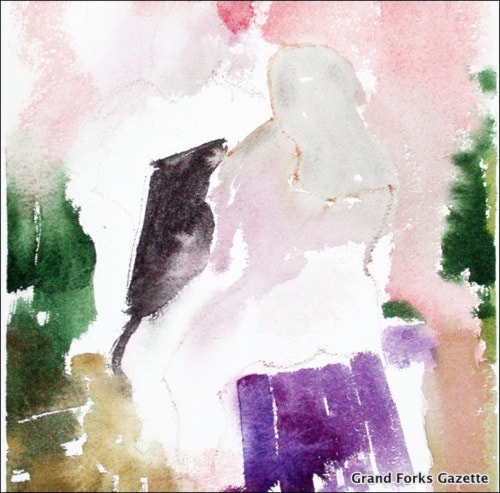The Art Palette is an open forum for discussion about art. Do please contact us at artpalette@hotmail.ca with feedback on what you read here or to let us know your thoughts on anything art.
Part 2 of excerpts from a lengthy and fascinating interview with artist Richard Reid by songwriter Dave Soroka.
DS: Any high points in terms of your career? Breakthroughs that might have happened at the canvas, that kind of thing?
RR: Probably the major one would be when I went to Europe to live. About two years after graduating, I went to Mexico for six months and did nothing there but paint. It was very inexpensive to live; I don’t know the significance of the work particularly other than just progression. A couple of years later we went to Europe.
DS: Now we’re into the ‘60s?
RR: Yeah, in 1960 my wife Bev and I went there and travelled probably for six months in a Volkswagen van, then got tired of travelling and rented a flat in London for the next four years.
DS: It would be fun to interview you and Bev together.
RR: I expect she would have a different take on things. Even in terms of the philosophy of art and so on; we’re very different really, as are most artists. I mean, there’s lots of areas of agreement but everyone comes at their work from a different place, from a different part of their soul.
One of the breakthroughs, I think, was when we got to London and I finally got my studio together in our little flat. It was the result of a lot of things happening.
The 1960s in Britain was suddenly very liberal in thinking – things like D.H. Lawrence’s Lady Chatterley’s Lover being published. There was a revolution in terms of overall thinking that seemed to coincide very strongly with the kind of painting I was doing.
I hesitate to use the word ‘erotic’ as being part of that liberalization but it kind of fits. But, it wasn’t about the pornographic part of erotic things; it was about the human condition.
That seemed to fit very strongly with the nature of my work. I don’t think I really knew what I was doing but I discovered it as a result of seeing a compatible world out there – a world that fit. I began to recognize it in my work, even though I’d probably been moving in that direction a long time.
DS: You once referred to yourself loosely as an abstract expressionist.
RR: The definition doesn’t really fit. It’s just a way of saying that’s where it began. You’re influenced by things you see or hear and they go into the subconscious and you naturally begin to express through the things you know.
DS: I find if I’m going to record, my toughest job has been to get John Lennon, Warren Zevon, Bruce Springsteen and Bob Dylan out of my studio so it’s just me at the mike. You find the same thing? Looking for your own voice?
RR: It’s kind of inevitable. Where do you find your own voice? If you’re born in isolation your own voice is based on that isolation – that’s the only experience you have. I mean, where can it come from but what you learn and experience?
DS: There are times I’ve had some success knowing it was really me and it’s pure.
RR: That’s like that revelation in the studio. Suddenly you realize you hit something. In art you can never really tell what that is but boy, you sure know it. I’ve never been able to define what that thing is.
DS: It’s like making the art right there in the moment.
RR: The moments are often done in isolation, when you’re not in control even though you are absolutely in control. Suddenly it all kind of happens. You can’t make it happen.
DS: It’s like hitting a moment of grace. It can last a minute or an hour.
RR: Yes, it’s the same thing if it happens on the canvas or wherever.
